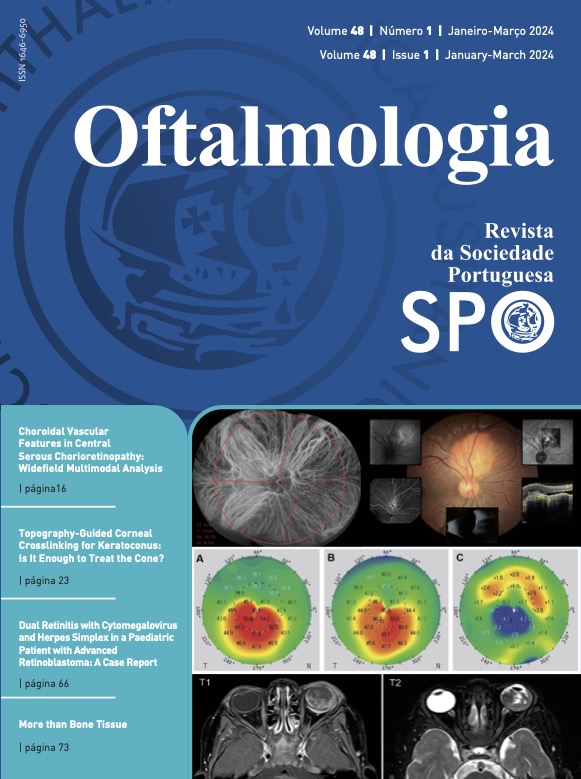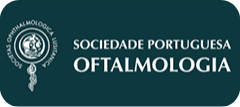Choroidal Vascular Features in Central Serous Chorioretinopathy: Widefield Multimodal Analysis
DOI:
https://doi.org/10.48560/rspo.28617Keywords:
Angiography, Central Serous Chorioretinopathy, Indocyanine Green, Tomography, Optical CoherenceAbstract
INTRODUCTION: Our objective was to evaluate choroidal vascular features of patients with central serous chorioretinopathy (CSC) using widefield (WF) swept-source optical coherence tomography (SS-OCT) and ultra-widefield (UWF) indocyanine green angiography (ICGA).METHODS: Observational study with a prospective design conducted in patients with CSC. All cases underwent UWF ICGA using a confocal scanning laser ophthalmoscopy (SLO) device and WF SS-OCT. WF en face OCT images of the choroid and mid-late UWF ICGA images were created using Photoshop. The image analysis protocol comprised the analysis of choroidal vascular features in UWF ICGA (symmetric vortex veins territories; pachyvessels crossing watershed territories; choroidal vascular hyperpermeability (CVH) and intervortex anastomosis) and WF en face SS-OCT images (pachyvessels crossing watershed areas and intervortex anastomoses). Cor- relation between the variables of interest was performed using the Pearson correlation coefficient. Statistical significance was set as <0.05.
RESULTS: A total of 23 eyes from 12 patients diagnosed with CSC were included in the analysis. Symmetry analysis in UWF ICGA showed asymmetric vortex vein territories in 16 eyes (70%). The most prevalent asymmetric territory was the inferior-nasal (10 eyes, 43%). Pachyvessels crossing choroidal watershed zones were present in 20 of eyes (87%) with a perfect agreement between UWF ICGA and en face UWF OCT (r = 1.0). Both horizontal and vertical watershed areas were crossed in 8 eyes (40%). Evaluation of intervortex anastomosis showed a higher prevalence when evaluated by en face WF OCT (26%, 6 eyes). A moderate correlation between asymmetric vortex vein territories and intervortex anastomoses was observed (r = 0.51). Mid-late CVH in ICGA was present in 19 cases (83%), among which 5 cases (26%) showed diffuse CVH. A moderate positive correlation (r = 0.53) was also observed between diffuse CVH and pachyvessels crossing both meridians.
CONCLUSION: WF en face SS-OCT can be used to detect non-invasively choroidal vascular anomalies in CSC. Pachyvessels crossing the horizontal and vertical meridians are moderately associated with diffuse CVH in ICGA, supporting its role as a non-invasive biomarker of choroidal venous insufficiency.
Downloads
References
Gass JD. Pathogenesis of disciform detachment of the neuroepithelium. Am J Ophthalmol. 1967;63:Suppl:1-139.
Bacci T, Oh DJ, Singer M, Sadda S, Freund KB. Ultra-Widefield Indocyanine Green Angiography Reveals Patterns of Choroidal Venous Insufficiency Influencing Pachychoroid Disease. Invest Ophthalmol Vis Sci. 2022;63:17. doi: 10.1167/iovs.63.1.17.
Hayreh SS. In vivo choroidal circulation and its watershed zones. Eye.1990;4:273-89. doi: 10.1038/eye.1990.39.
Dansingani KK, Balaratnasingam C, Naysan J, Freund KB. En face imaging of pachychoroid spectrum disorders with swept-source optical coherence tomography. Retina. 2016 Mar;36(3):499-516. doi: 10.1097/IAE.0000000000000742.
Yannuzzi LA. Indocyanine green angiography: a perspective on use in the clinical setting. Am J Ophthalmol. 2011;151:74551.e1. doi: 10.1016/j.ajo.2011.01.043.
van Dijk EH, Boon CJ. Serous business: Delineating the broad spectrum of diseases with subretinal fluid in the macula. Prog Retin Eye Res. 2021;84:100955. doi: 10.1016/j.preteyeres.2021.100955.
Hiroe T, Kishi S. Dilatation of asymmetric vortex vein in central serous chorioretinopathy. Ophthalmol Retina. 2018;2:152-61. doi: 10.1016/j.oret.2017.05.013.
Pang CE, Shah VP, Sarraf D, Freund KB. Ultra-widefield imaging with autofluorescence and indocyanine green angiography in central serous chorioretinopathy. Am J Ophthalmol. 2014;158:362-71.e2. doi: 10.1016/j.ajo.2014.04.021.
Alasil T, Ferrara D, Adhi M, Brewer E, Kraus MF, Baumal CR, et al. En face imaging of the choroid in polypoidal choroidal vasculopathy using swept-source optical coherence tomography. Am J Ophthalmol. 2015;159:634-43. doi: 10.1016/j.ajo.2014.12.012.
Schindelin J, Arganda-Carreras I, Frise E, Kaynig V, Longair M, Pietzsch T, et al. Fiji: an open-source platform for biologi-cal-image analysis. Nat Methods. 2012;9:676-82. doi: 10.1038/nmeth.2019.
Ramtohul P, Cabral D, Oh D, Galhoz D, Freund KB. En face Ultrawidefield OCT of the Vortex Vein System in Central Serous Chorioretinopathy. Ophthalmol Retina. 2023;7:346-53. doi: 10.1016/j.oret.2022.10.001.
Gallego-Pinazo R, Dolz-Marco R, Gómez-Ulla F, Mrejen S, Freund KB. Pachychoroid diseases of the macula. Med Hypothesis Discov Innov Ophthalmol. 2014;3:111-5.
Spaide RF, Gemmy Cheung CM, Matsumoto H, Kishi S, Boon CJ, et al. Venous overload choroidopathy: A hypothetical framework for central serous chorioretinopathy and allied disorders. Prog Retin Eye Res. 2022;86:100973. doi: 10.1016/j.preteyeres.2021.100973.
Hayreh SS. Physiological anatomy of the choroidal vascular bed. Int Ophthalmol. 1983;6:85-93. doi: 10.1007/BF00127636.
Matsumoto H, Hoshino J, Mukai R, Nakamura K, Kikuchi Y, Kishi S, et al. Vortex Vein Anastomosis at the Watershed in Pachychoroid Spectrum Diseases. Ophthalmol Retina. 2020;4:938-45. doi: 10.1016/j.oret.2020.03.024.
Matsumoto H, Mukai R, Saito K, Hoshino J, Kishi S, Akiyama H. Vortex vein congestion in the monkey eye: A possible animal model of pachychoroid. PLoS One. 2022;17:e0274137. doi: 10.1371/journal.pone.0274137.
van Rijssen TJ, van Dijk EH, Yzer S, Ohno-Matsui K, Keunen JE, Schlingemann RO, et al. Central serous chorioretinopathy: Towards an evidence-based treatment guideline. Prog Retin Eye Res. 2019;73:100770. doi: 10.1016/j.preteyeres.2019.07.003.
Downloads
Published
How to Cite
Issue
Section
License
Copyright (c) 2023 Revista Sociedade Portuguesa de Oftalmologia

This work is licensed under a Creative Commons Attribution-NonCommercial 4.0 International License.
Do not forget to download the Authorship responsibility statement/Authorization for Publication and Conflict of Interest.
The article can only be submitted with these two documents.
To obtain the Authorship responsibility statement/Authorization for Publication file, click here.
To obtain the Conflict of Interest file (ICMJE template), click here





